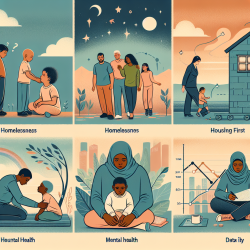Introduction
In the realm of speech-language pathology and therapeutic interventions, understanding the broader social determinants of health is crucial. A recent study titled The Association Between Experiencing Homelessness in Childhood or Youth and Adult Housing Stability in Housing First sheds light on the long-term effects of childhood homelessness on adult housing stability. This blog post aims to translate these findings into actionable insights for practitioners working with vulnerable populations, particularly children and youth.
The Study's Findings
The study conducted in Metro Vancouver, Canada, involved 297 participants who had experienced homelessness and serious mental illness. It found that those who first experienced homelessness in childhood or youth were significantly less likely to achieve stable housing as adults, even when participating in the Housing First (HF) program. Specifically, the odds of achieving housing stability were reduced by nearly half for those who experienced homelessness before the age of 25.
Implications for Practitioners
For practitioners, these findings underscore the importance of early intervention and tailored support strategies. Here are some key takeaways:
- Early Identification: Assessing the age at which clients first experienced homelessness can help identify those at greater risk of instability and tailor interventions accordingly.
- Comprehensive Support: Beyond housing, providing access to mental health services, educational support, and life skills training can address the broader needs of these individuals.
- Collaboration: Working with multidisciplinary teams, including social workers, mental health professionals, and educators, can enhance the support network for affected individuals.
Encouraging Further Research
The study highlights a significant gap in the literature regarding the long-term impacts of childhood homelessness. Practitioners are encouraged to engage in further research to explore effective interventions and support mechanisms. Collaborating with academic institutions and leveraging data-driven approaches can contribute to a deeper understanding of these complex issues.
Conclusion
Addressing the needs of individuals who have experienced homelessness in childhood or youth requires a holistic and informed approach. By integrating the findings of this study into practice, we can enhance the support provided to vulnerable populations, ultimately improving their long-term outcomes. For those interested in delving deeper into the research, the original study can be accessed here.










